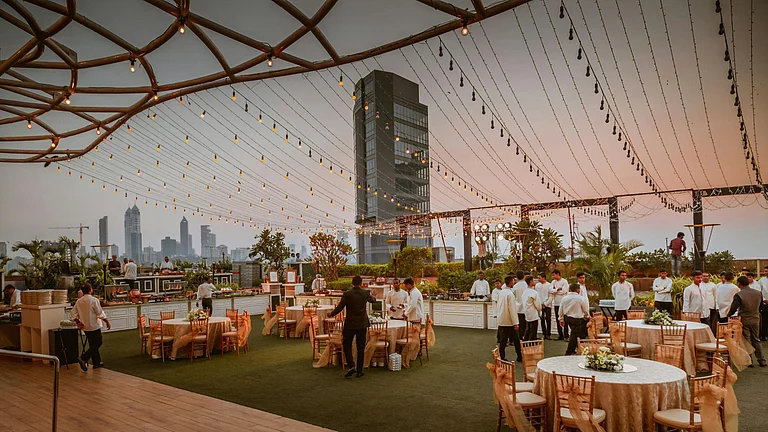I am glad it's none other than B.G.Verghese who has written an (official?) rejoinder in Outlook (A Poetic Licence, July 5) to my essay The Greater Common Good. Glad, only because I trust that he is an honourable man defending long-held beliefs and not a venal one seeking to line his wallet. So at least we have the semblance of a debate on our hands. What more can one ask for?
Almost everyone who wants to rubbish my argument begins by paying me extravagant, back-handed compliments about my 'poetic writing'. Almost as though poetry by definition is imprecise, unsubstantiated mush. Not something that Real Men who build Big Dams dabble in.
"The poetry was charming. The facts wrong," Mr Verghese says. The poetry may have been charming (though it's not an adjective that I would choose), but the facts are right.
I won't restate my case, let me simply say that I stand by every single fact that Mr Verghese has tried to dispute. Every single argument. The Greater Common Good is now available as a book. Each fact is backed up by sources independent of the NBA (whose cause he accuses me of "parroting") and listed in the end-notes of the book.
I don't expect someone like Mr Verghese who has served on the Narmada Planning Group and spent a good part of his life advocating Big Dams to suddenly screech to a halt and jettison his point of view. But it's bad strategy on his part to try and derail a huge, and hugely necessary, national debate by picking out at random facts from the tail end of the argument, turning it into techno-jargon, stirring in some personal invective and serving it up as a whole new kind of soup.
The Sardar Sarovar dam, I continue to maintain, is an economic, technological, ecological, and human disaster in the making. The benefits that its proponents promise it'll bring-both in terms of power generation and irrigation-have been exaggerated to laughable levels. In my essay I have shown how the politically powerful lobbies-sugar farmers, five-star hotels, water-parks and urban centres-are already poised to siphon off the irrigation water from the main canal long before it reaches Kutch and Saurashtra-the billboards of the Gujarat government's Thirst Campaign.
Mr Verghese says that the "planned irrigation delta will not permit cane farming which is discouraged". (There's a difference between 'not permitting' and 'discouraging'.) He says that the 14 existing sugar factories are outside the command area. What he doesn't mention is that licences have been issued for about a dozen new ones, many of them in the command area. The chief promoter of one of them, the Sardar Sugar Factory, is Sanat Mehta, who was chairman of the Sardar Sarovar Narmada Nigam for several years. The chief promoter of another was Chimanbhai Patel, former chief minister of Gujarat, who (along with his wife) was the most vocal, ardent proponent of the Sardar Sarovar dam. He liked to call himself 'Chhota Sardar'.
The people of Kutch and Saurashtra, who have endured water-shortages for years, have begun to recognise government propaganda for what it is. Civil unease is stirring as realisation dawns that the Sardar Sarovar is mopping up their money but is not going to solve their water problems. That the solution lies not with the government but with themselves. The Gujarat Land Development Corporation estimates that there is at least 15 to 20 million acre feet of rainwater that can be harvested by local watershed harvesting schemes in Kutch and Saurashtra. (The Sardar Sarovar promises, on paper, 3 million acre feet to these areas.) In several villages, entirely through peoples' initiatives, successful water harvesting schemes are already under way. Hundreds of thousands of wells are being recharged with rainwater that was flowing away unused. So much for the government of Gujarat's claims that there are no alternatives to the Sardar Sarovar.
Recently, a people's organisation-the Kutch Jalsankatan Nivaran Samiti-filed a case against the government of Gujarat and the Sardar Sarovar Narmada Nigam in the Gujarat High Court, asking for clarification of when, where and how much water will be delivered to the districts of Kutch.
Meanwhile, what does Mr Verghese suggest we do about the fact that there's a possibility that the people who are supposed to benefit from the project-the people in whose name the frenzy is being drummed up-may not, after all, get any water at all?
"Why not wait and see?" he says!
You bet. Why not submerge a civilisation, uproot a few hundred thousand people, make the people of Kutch and Saurashtra linger on in hope for a couple more decades, shell out another few thousand crores of rupees of public money and see how it all pans out. Is this an argument?
Mr Verghese was upset about the fact that I scoffed at the government's scheme of a centralised electronic irrigation system to deal with problems of potential water-logging. I admit I scoffed. How can one not?
But that apart, I did suggest that they try it out in a pilot scheme before using public money to experiment on the 1.8 million hectares of the Sardar Sarovar command area.
Why not, for instance, experiment in the Bargi command area where the dam irrigates only five per cent of the area it promised it would?
Or in the Tawa command, where after 27 years, the capacity utilisation (the amount of area it actually irrigates compared to the amount of area it was designed to irrigate) is 54 per cent (government figures)?
Or pick any section of the millions of hectares of water-logged land all over India-in Punjab, Haryana, Rajasthan.
If you include the costs of command area drainage and drinking water distribution systems so that the Sardar Sarovar Projects can at least pretend to achieve what they promise, we're talking about thousands of crores of rupees of public money. Enough, probably, to fund local water harvesting schemes in every village in Gujarat.
As for his defence of 'compensatory afforestation' as a way of atoning for schemes that destroy natural, old growth forest-it sounds quite reasonable doesn't it? Cut down a forest and plant one somewhere else. Except that to assume that a natural forest is the sum of its trees is an absurd notion. You don't need a PhD in ecology to tell you-not in the '90s-that you cannot cut down millions of years of evolutionary adaptation and conjure it up somewhere else. It's like trying to compensate the loss of a wildlife reserve with a poultry farm. The submontane dry deciduous forests that clothe the Satpuras and the Vindhyas are among the most endangered sub-tropical ecosystems. I'm afraid canal plantations just don't make the cut.
Mr Verghese also keeps very quiet about where all the land for compensatory afforestation is going to come from. Whose land will it be, I wonder?
This brings me to the saddest, most cruel part of his 'Rejoinder'-Mr Verghese's attitude towards the human price that is being paid for Big Dams in general and the Sardar Sarovar in particular. It's chilling to see a private citizen, a thinking private citizen, so readily regurgitate State Publicity. It's ludicrous to portray the NBA as a terrorist organisation that parades government officers naked and obstructs justice. There is a full-blown civil disobedience movement in the Narmada Valley. And it's happening on a scale that cannot be artificially staged, or manipulated.
Please Mr Verghese. Come to the valley with us in July. Open your eyes and try and see like a subject instead of a spokesperson of the State.
If it's all true, this vision of sunshine and roses that Mr Verghese and the Gujarat government want us to believe in, then what's all the secrecy about? Why not release all the studies that have been done into the public domain (including the unfavourable ones)? Why not have them peer reviewed? Why not publish a detailed break-up of the costs? Why not account for the amount spent so far? Why not clarify where the remaining money is going to come from, on what terms? Why block every attempt at a review? Why prevent the fmg Committee from entering Gujarat? Why ransack the NBA office and burn its documents? Why prevent the Commissioner for Scheduled Castes and Tribes from going to the dam site? Why refuse permission to the World Commission on Dams to visit the dam site? Why prevent a committee appointed by the Central government from investigating the impact of the closure of the sluice gates? Why prevent the Union welfare ministry from assessing the r&r situation? What's the paranoia all about?
After all, the government of Madhya Pradesh (the state through which 90 per cent of the river flows, and the state in which the remaining 3,199 dams envisaged by the Narmada Valley Development Project are going to be built) is willing to listen. It has filed a case in the Supreme Court admitting that there is less water in the river than when the plan was first conceived. It has agreed to review all the projects that are still on the anvil (except, strangely, the Maheshwar dam). It is actively funding and encouraging local water-harvesting schemes.
Why is the government of Gujarat (and its spokesperson) so stubborn? Why do they insist on repeating their old, obsolete illogic?
"Dams displace," B.G. Verghese says. "So does acute deprivation in the Narmada Valley, but in a far higher ratio."
He then goes on to suggest that displacement is the government's way of relieving acute deprivation! That the major beneficiaries of the Sardar Sarovar dam are "tribals, marginal farmers and women". (As though being a woman precludes you from being a tribal or a marginal farmer.)
Mr Verghese wants us to believe that the State is actually doing people a favour by uprooting them, taking them away from their forests and their river, submerging their lands and homes, drowning their sacred sites, smashing their ancient community links and resettling them against their will.
He doesn't just want to destroy a civilisation. He wants to spit in its face while he's at it.
Anybody who argues against this, according to him, is "glorifying the noble savage". I, for one, am accused of wanting them to spend their lives "grubbing for roots, deprived, impoverished and 'protected' by the nba".
Why not add the word "grunting", Mr Verghese? "Grunting and grubbing for roots"-doesn't that sound more like it? Suitably bestial?
The tribal people whose villages are slated to be submerged by the Sardar Sarovar Reservoir are very, very poor people. But they have enough to eat. They are self-sufficient. They have a river that gives them water and fish and fertile land, they have a forest that provides them with fruit, medicine and fodder for their cattle. They don't have pinstriped suits, but they are at least insured against famine and drought. Resettlement will rend the social and ecological links that help them survive. It can only impoverish them further. Is it possible that Mr Verghese really believes that they can be better off in a city slum?
If Mr Verghese is right about the State having the well-being of tribal people uppermost in its mind, why is it that for 50 years there have been no roads, no schools, no clinics, no wells, no hospitals in the areas where they live? Why is it that for all these years the State didn't bother to take steps to equip the people they care so deeply about, for the world they were going to be dumped in? Why is it that the first sign of 'development'-a road-brought only terror, police, beatings, rape, murder? Why must the offer of 'development' always be conditional, ie: you give up your lands, your homes, your fields, your language, your gods, and we'll give you 'development'. Why doesn't the State help people in the Narmada Valley and the people of Kutch and Saurashtra to harvest their rainwater and recharge their groundwater?
Let's not be coy. Let's give this a name. It's not social engineering that Mr Verghese is after. It's garbage disposal. It's not even a particularly sanitary method. Occasionally people die in the bins they've been dumped in. Like the seven not so long ago, in the Rameshwarpuram site. Of contaminated drinking water. Of chronic malnutrition. (Publish the report!)
He claims that 88 per cent of the families that will be affected when the dam is 85 metres high have already been resettled. (This, when the governments of Maharashtra and Madhya Pradesh are giving out mixed, muddled signals about the availability of land for this purpose). Never mind that the dam is already 88 metres high if you include the hump. Never mind that in May '99, two months before the monsoons, the Narmada Control Authority was still waiting for the various states to report to it on the progress they had made on assessing land availability for those whose villages are likely to be submerged! Never mind that the calculations of which village will be submerged when, are invariably wrong. For instance in the monsoon of '94, when the dam was only 69 metres high, a village that was slated for submergence at 90 metres, came under water.
Here we are, 15 years after the project began, still scrabbling around for land to offer people being displaced by this one dam when it's still far from its final projected height. What about the rest of the three thousand several hundred serial dams planned on the same river? What about the millions of potential 'oustees'? Are our cities ready to receive them?
It's so sad to see a man of Mr Verghese's stature work so hard to elide the main argument of the essay he takes issue with. His silence on the big things is more eloquent than his specious arguments about the small ones. How gratefully he grasps at government statements, government statistics, government promises. This when dam after dam has shown how benefits are inflated, costs deflated and the number of displaced people consistently, grossly, underestimated.
He doesn't even address the issue I raised about the government's definition of who it considers 'project-affected'-of how the number of people actually affected is more than double what they say it is.
The truth is that our differences have little to do with technical data. They have to do with a fundamental difference in worldview. Here is a man who believes that mammoth, State-supervised engineering projects are the solution to human problems.
I disagree. With its philosophy and method. With the scale of the operation. With its fundamental premise.
Fifty years on, hard as it may be for some of us, we have to admit that Big Dams have let this country down. They are monuments to political corruption and social inequity. Big Dams are just not what they promised to be when B.G. Verghese was a young man.
India is the world's third largest dam builder with 3,600 large dams, 3,300 of them built after independence, a 1,000 more are under way. Yet today, there are more drought-prone and flood-prone areas than there were in 1947!
Big Dams have generated electricity, certainly. Yet more than 80 per cent of rural households have no electricity. 250 million people have no access to safe drinking water, and over 350 million live below the poverty line.
Food production has risen, but according to a paper presented to the World Commission on Dams by Himanshu Thakker, Big Dams can claim the credit for only 12 per cent of this.
Since Independence, Big Dams alone have displaced between 33 and 40 million people. Most of them are either Dalits or tribal people. (Yet India does not have a National Rehabilitation Policy).
What Big Dams have done is to sequester resources from the vast majority of the people who live in rural India and divert them to the cream of the crop that lives in urban India.
Anybody who wants to defend this position should not hold back.
Let them say that this is the way things ought to be. That villages should subsidise cities. That the poor must subsidise the rich. Let them say that it's acceptable for forty million people to be driven from their homes in order that we, the metropolitan elite, continue to have an unlimited supply of electricity and running water. Let whoever wants to defend Big Dams drop this comfortable mask-this civilise-the-savage missionary position-and come right out and stand up for feudal values.
The climate seems terrifyingly right. Soon somebody just might. The savagery of the civilised.
I can't let this go without commenting on Mr Verghese's snide remarks about my essay on the nuclear tests. I don't know this for a fact, but I'm assuming from his tone that he doesn't lose sleep over the BJP government's programme of nuclear weaponisation. To a man who is comfortable with the idea of a wasted world, what's a wasted valley?























